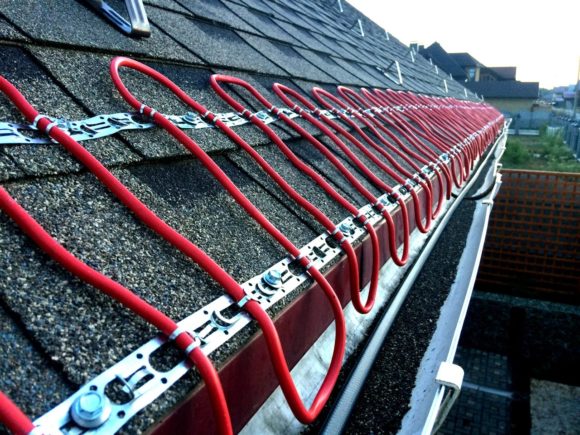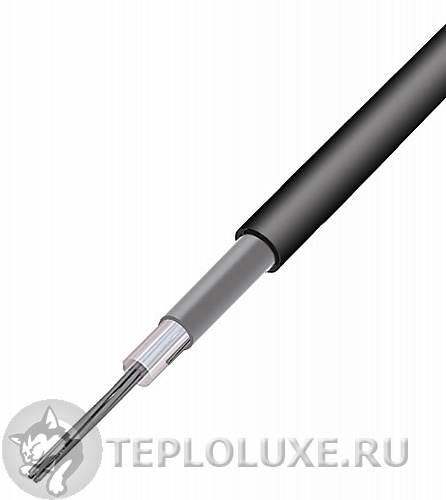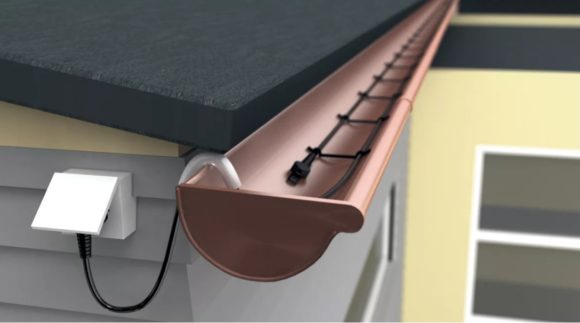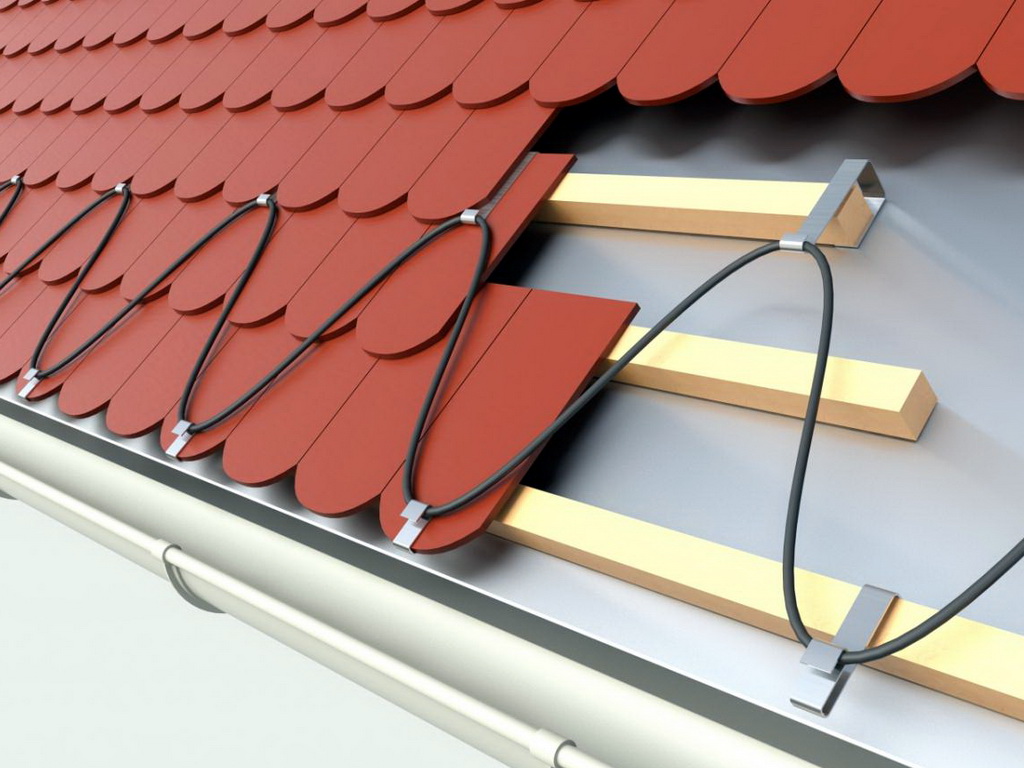During the winter, a large amount of snow accumulates on the roof of the houses. As it melts, it can form ice and icicles. To avoid this, equip the heating of the roof and gutters. Various types of systems presented on the construction market, and reasonable prices of sets allow you to do it yourself without the involvement of professionals.
Content
Cable heating systems

Snow settling on the roof surface can melt, forming ice on overhangs or in drain pipes. This process occurs due to the difference in temperature between the air and the roofing material. In the spring, under bright sunshine, snow melts, turning into water. The latter, if the air temperature is less than zero, will accumulate in the form of ice on various components of the roof. The formation of too large growths is fraught with damage to the coating, rafters, gutters or falling icicles from a height. Flying masses of ice, in addition to damage to the building, I can harm a person under the overhang.
The heating system allows you to avoid the accumulation of frozen masses of water. It is mounted in places of possible ice formation - roof overhangs, drainage trays and pipes. De-icer - heating cable, which is placed in problem areas or over the entire surface of the roof. The latter method is much more expensive, but it saves the owner of the property from mechanical cleaning of snow, preserves the integrity of the coating and drainage elements.
For the smooth removal of melt water from the roof, sets of heating cables and control modules are used. The first is laid along all gutters and overhangs of the roof. They convert electricity to heat, which melts snow. Control modules automatically, without human intervention, turn on the system. Sensors react to changes in air temperature, the appearance of precipitation or water in the sewage system.
An avalanche of snow can damage the heater. To protect it, limiters are installed that delay the moving masses.
Heating cable

The basis of the system is cable. It is he who creates the heat that melts the snow. The heating cable for the roof and gutters is of two types: self-regulating and resistive. The first has a complex structure of two heating cores surrounded by a special matrix, which changes its resistance with temperature fluctuations. So, the colder it is on the street, the more the cable heats up. The heating system based on this element does not need automatic regulation using complex sensors.
The advantage of a self-regulating cable is ease of installation. It can be cut into short lengths up to 20 cm long. They are conveniently laid in gutters, skates and overhangs. In addition, the cable allows bending at an acute angle, crossing and twisting. Cons of the application - a high price (from 220 rubles per linear meter), as well as rapid aging of the matrix. Over time, it degrades, which leads to cable failure.
Resistive systems are several times cheaper, but despite the simplicity of the heater, they require complex control. The cable consists of a current-carrying core with a high resistance. When voltage is applied to it, the core warms up, giving off heat to the environment. Resistive cable benefits:
- low price (from 60 rubles per linear meter);
- lack of starting currents;
- ease of installation;
- constant power.
The disadvantages of this type of system include high power consumption, the complexity of the calculations, the occurrence of local overheating, short service life. When laying the resistive cable, it is important to precisely balance the heating areas. If this is not done, some zones may remain cold, while others, on the contrary, may be excessively hot. To avoid this, identical cable segments are switched into separate groups. The inclusion of the divided sections is carried out by an electronic controller, which receives signals from sensors located in the places of cable laying.
Management components
The heating system needs additional components - control cabinet, distribution blocks, sensors, controller. Switching kits consist of signal and power wires, mounting boxes, couplings, ensuring tightness. Distribution blocks are usually installed under the roof. This reduces the total length of the supply cables. Sensors of temperature, presence of precipitation and melt water are placed directly in the drain gutters, drains, on the roof surface. Sensors collect weather information to quickly manage the system.
Information from the sensors enters a software device that sets the operating mode depending on the weather.
There are two ways to control the on / off of the heating cable: a simple thermoregulating device or a digital controller. The first option works according to a simplified scheme, when the signals come only from thermal sensors. However, such control is unstable and requires user intervention. Autonomous systems are equipped with digital controllers. A sophisticated electronic control unit can be programmed to configure optimal operating modes. The controller will quickly turn on or off the heating when weather conditions change.

In addition to the main components, the system has auxiliary equipment. For self-assembly, you need to additionally prepare:
- Control panel (metal or plastic). Its size should be enough to accommodate all control components, including the controller.
- Input machine. Depending on the type of system, a single or three phase switch. The rated cut-off current is determined by calculation, but the machine is selected an order of magnitude more powerful.
- Residual Current Device
- The contactor is magnetic. It is necessary for switching power circuits. The size must correspond to the rating of the input machine.
- Control light indicator. Apply a small incandescent lamp or LED in a protective housing. The indicator indicates the presence of voltage and the inclusion of heating.
- Fasteners, consumables. During installation, you will need roofing nails, self-tapping screws, brackets, electrical tape and a heat shrink tube.
Features of arranging a heating system
The simple system design allows you to install all the components yourself. For effective heating, you need to determine the location of the cable. As a rule, these are areas of ice formation and snow melting. The density of the loops depends on the type of heating cable, its size, power. The exact recommendations can be found in the accompanying documentation supplied by the manufacturer.
The surface on which they plan to lay the cable should not have sharp edges and sharp bends. Irregularities can damage the insulation, resulting in a malfunction of the entire system. To form sharp corners, the cable is cut and then connected using couplings. Heating elements are fixed to the roof with mounting foam or double-sided tape. Do not nail or screw with screws - they will violate the tightness of the material. In convenient places place mounting boxes, control cabinet. A controller and auxiliary equipment are installed in them. Assemble the circuit according to the wiring diagram.
The operation of housing in a cold climate forces the owners to equip the heating of the roof and gutters. This will help to avoid possible damage to the structural elements of the building and protect pedestrians from falling heavy ice blocks on them. And even a novice master can assemble a simple system on their own.


Alas, no comments yet. Be the first!